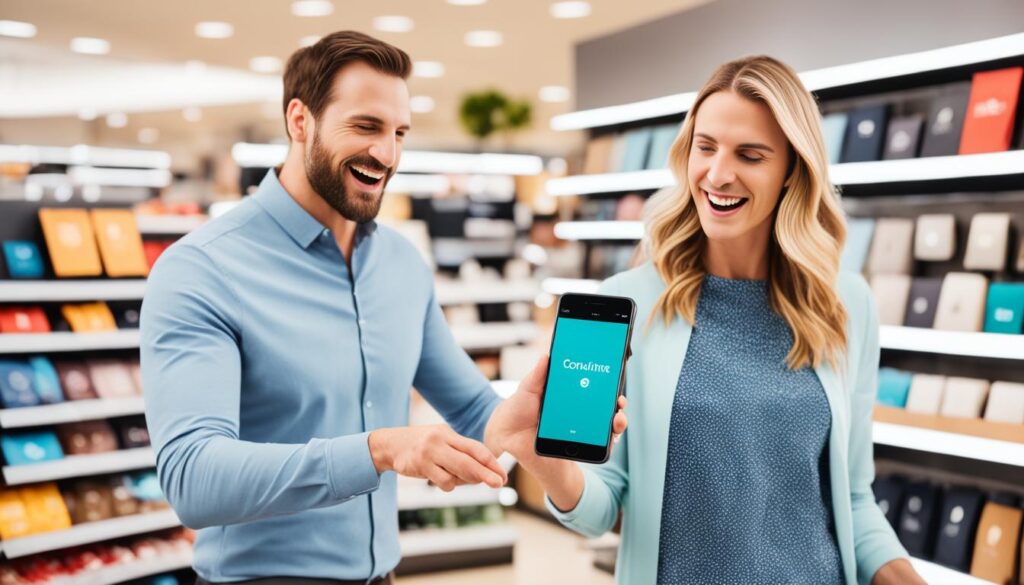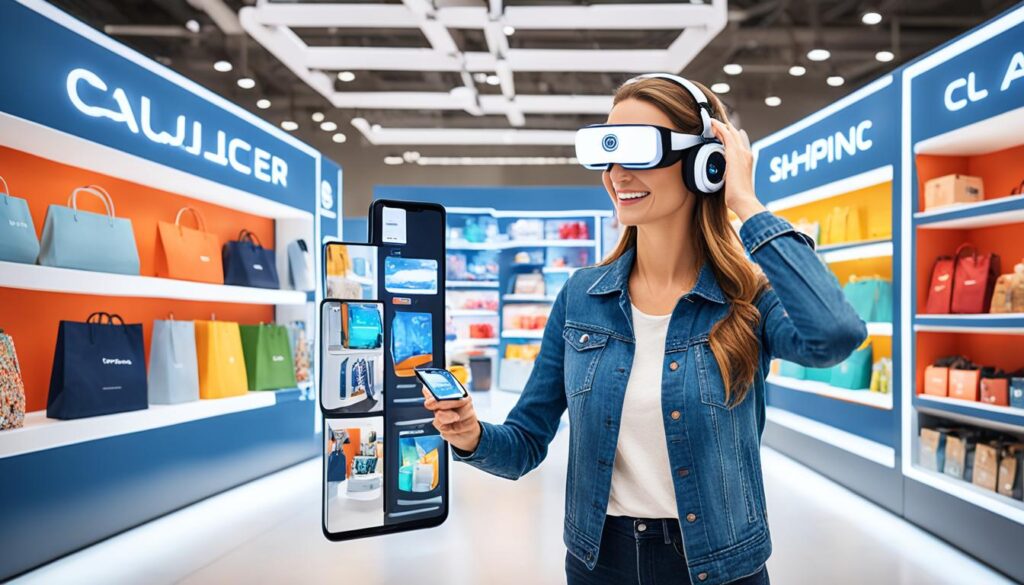E-commerce is booming like never before. Experts forecast that by 2026, worldwide retail e-commerce sales will top 8 trillion dollars. This massive number shows the huge growth and opportunity in online markets. To stay competitive, online sellers must keep up with key trends affecting e-commerce.

Key Takeaways:
- Unified omnichannel experiences are essential to cater to consumers shopping across various channels and touchpoints.
- Artificial intelligence plays a vital role in personalizing customer experiences and optimizing supply chain logistics.
- Social commerce is on the rise, with consumers increasingly discovering and purchasing directly from social media apps.
- Sustainability is a priority for consumers, who expect brands to show meaningful progress towards eco-conscious options.
- Personalized customer service is crucial in shaping brand perception and fostering customer loyalty.
Unified Omnichannel Experiences
Nowadays, consumers use many channels to shop. They use online stores, third-party marketplaces, and social media apps. They search these places to find and buy products.
Retailers need to keep up with changing times by being active on all key online platforms. This helps them reach and serve their target customers better. A unified approach across channels ensures a smooth experience for customers at every step.
Flexibility in fulfillment is crucial for customers. They want different options for getting their purchases. Retailers who offer same-day delivery, click-and-collect, or ship-to-store stand out. This improves customer satisfaction.
Social commerce is becoming vital too. Platforms like Facebook, Instagram, and Pinterest are now key shopping spots. Retailers can use these platforms to show off their products. A seamless buying process on these platforms is essential.
“Social commerce provides a unique opportunity for retailers to engage with customers where they spend a significant amount of their time: social media apps.”
Personal service across channels is also important. Retailers should use technology and training for personalized support. This includes tailored recommendations, proactive communication, and quick issue resolution.
Benefits of Unified Omnichannel Experiences:
- Enhanced customer satisfaction and loyalty
- Increased sales and revenue
- Improved brand perception and reputation
- Better understanding of customer behavior and preferences
- Opportunities for cross-selling and upselling
Retailers can provide a seamless customer journey by combining online and offline channels. This strategy meets customer needs and helps businesses grow in a competitive market.
| Key Strategies for Unified Omnichannel Experiences | Benefits |
|---|---|
| Establishing a strong presence on multiple online platforms | Increased visibility and reach |
| Offering flexible fulfillment options | Enhanced customer convenience |
| Embracing social commerce | Expanded customer reach and engagement |
| Providing personalized customer service | Improved customer satisfaction and loyalty |
Artificial Intelligence
Artificial intelligence (AI) is changing the game in e-commerce. It gives retailers strong tools to better customer experiences and refine logistics. Businesses gain personalized services, greater efficiency, and increased profits thanks to AI.
AI’s big win in e-commerce is offering personalized customer experiences. It analyzes data to understand what consumers like and how they shop. Retailers can then offer tailor-made product suggestions and deals, boosting customer happiness and loyalty.
By automating and refining supply chains, AI is revolutionizing them. Machine learning helps predict demand, manage inventory, and plan deliveries. This cuts costs and boosts efficiency. AI chatbots also offer quick help to customers, making their shopping smoother.
Additionally, AI is essential in reshaping digital marketing. It helps businesses understand large amounts of customer data for better decision-making. AI tools give insights into customer groups and the impact of marketing efforts. This allows for sharper marketing strategies. AI also streamlines tasks like ad targeting, freeing up valuable time.
Addressing Transparency and Trust
Retailers must ensure customers trust how AI uses their data. Being open about AI use and protecting customer data is key. Transparency builds customer trust.
Putting AI into e-commerce needs careful planning. Retailers must align AI with their goals for the best outcome. AI helps craft unique shopping experiences and keeps businesses competitive.

Social Commerce
Social commerce is changing how we buy things. More shoppers are using social media apps to shop. This trend mixes social media’s reach with online shopping for a fun experience.
Retailers can now reach more people through social commerce. They use popular social media apps to show their products. This lets them talk directly with customers and boost sales in a real way.
For social commerce success, being real with your audience is key. True connections that touch consumers are important. Talking to customers through comments or messages helps build trust and a strong online space.
“The rise of social commerce has fundamentally transformed the way businesses engage with their customers. By integrating shopping features into social media apps, we have created a seamless experience that empowers users to shop directly from their favorite platforms.” – Social Media App CEO
Retailers should focus on mobile users first. Most social media fans use their phones to log in. Making the shopping experience good on mobile means more sales and happy customers.
Social commerce offers new chances for businesses to meet their customers and grow income. By leading in this area, retailers can make the most of social media as a great way to sell.

Sustainability
Today, shoppers are more mindful of the environment. They look for eco-friendly products. These products match their values and help the planet.
Yet, some are wary of “greenwashing” by brands. They seek real action on sustainability. Transparency is key for these shoppers.
E-commerce plays a big role in this green movement. They can lessen their environmental impact. They do this by being mindful in how they operate and source products.
Double Down on Sustainability Practices
E-commerce must fully embrace sustainability. This includes using ethical suppliers and green packaging. They also should focus on recycling.
It’s also vital they talk about their green steps clearly. Sharing their efforts can build trust with eco-conscious customers.
“Sustainability is a journey, not a destination. Companies need to continuously strive for improvement and transparency, engaging with customers on their sustainability efforts.” – Jane Smith, Founder of Sustainable Solutions
Collaboration and Innovation in Sustainable Practices
Working together is essential for eco-friendly change. E-commerce can join hands with green groups. This helps them learn and adopt better practices.
Innovation is also crucial. By exploring new tech and processes, companies can cut down on their eco-footprint. This might mean using renewable energy or making logistics more efficient.

E-commerce can truly make a difference with sustainability. By offering eco-friendly choices and proving their efforts, they meet customer needs. They also help in creating a greener future for everyone.
Personalized Customer Service
Customer service is crucial in e-commerce. It shapes brand perception and builds loyalty. As online shopping grows, custom service is key.
It’s not just about solving problems. It means knowing each customer’s needs and preferences. This way, businesses can build strong relationships.
To provide this, businesses use customer data. They analyze interactions to understand individual preferences and behaviors. This helps personalize recommendations and support.
Company XYZ values personalized customer service highly. Our agents use advanced CRM tools to know customers well. Thus, we exceed expectations with tailored service.
Businesses should also communicate proactively and with empathy. Quick responses and genuine care enhance customer experiences. Meeting individual needs can turn unhappy customers into loyal ones.
Agents need the right tools for personalized help. This includes product knowledge and efficient communication. Training improves their personalization skills.
Each customer interaction is a chance to impact positively. Prioritizing personalized service and using insights can strengthen connections. This improves brand perception and drives success.

| Benefits of Personalized Customer Service | Examples |
|---|---|
| Enhanced customer satisfaction | Addressing individual needs and preferences |
| Increased customer loyalty | Providing personalized recommendations and promotions |
| Positive brand perception | Delivering exceptional service that exceeds expectations |
| Word-of-mouth referrals | Turning satisfied customers into brand advocates |
| Higher customer lifetime value | Fostering long-term customer relationships |
Voice Search
Smart speakers and voice assistants have changed how we search for info and shop online. Users are now talking to their devices to find what they need quickly. This makes it vital for online shops to make their websites voice search friendly.
To help users find your site, your voice search answers must be clear and short. Here are ways to improve your site:
- Conversational Keywords: Use natural speech patterns and long-tail keywords on your site. Voice searches are more like conversation, so match how people really talk to boost your rankings.
- Structured Data Markup: Use structured data markup to give search engines more info about what you offer. It helps search engines show more about you in voice search.
- Mobile Optimization: Make sure your site works great and loads quickly on phones. Since many voice searches happen on mobile, a smooth mobile site can lead to more happy customers and sales.
“Making your site better for voice search can attract more people using voice to shop. Use conversational keywords and structured data markup for better visibility in voice search results.”
Don’t just fix your site – use voice search in your ads too. Make ads and apps that respond to voice for a deeper connection with your audience.
The Benefits of Voice Search Optimization for E-commerce Brands
| Benefits | Description |
|---|---|
| Improved Visibility | Making your site voice search friendly boosts your presence in search results, leading to more visitors. |
| Enhanced User Experience | Voice search makes interacting with your brand easy and hands-free, offering a smoother experience. |
| Increased Conversions | Quick and direct answers can help turn curious searchers into customers much faster. |
| Staying Ahead of Competitors | Being quick to optimize for voice search puts you ahead of others who haven’t yet taken the step. |
For e-commerce, staying ahead means making your site work well with voice search. Adding conversational keywords, helpful data markup, and a mobile-friendly design sets you up for success in voice commerce.

Mobile-First UX Design
Today, more people shop on their phones. This makes mobile-first UX design a top priority for companies. A great mobile experience grabs users’ attention and keeps them coming back.
Using fingerprint and facial recognition improves security for online buying. This tech makes buying things quicker and easier. Customers feel safer and more willing to buy this way.
Businesses should make special apps for mobile users. These apps need to be easy to use, fast, and offer personalized content. A good mobile app can lead to more sales and loyal customers.
Having mobile-friendly payment methods is also key. It makes checking out easier and encourages users to finish buying. With various payment options, shopping on mobile becomes hassle-free.

Focusing on mobile-first UX design helps businesses grow in e-commerce. A smooth mobile experience increases customer happiness, sales, and loyalty. Today, being mobile-friendly is a must for success.
Inflation and Redefining Value
Inflation changes how much we can buy with our money. People are now more careful with their purchases. They look for real value for the money they spend. Businesses must highlight the benefits and value of their products to keep customers coming back.
The Impact of Inflation on Consumer Spending
Inflation means prices go up and buying power goes down. With tighter budgets, people think more about where to spend their money. They carefully judge the worth of each item.
It’s not just about who has the cheapest price anymore. Yes, price is still important. But people also want items that last long and are of high quality.
Redefining Value in the E-commerce Landscape
Businesses have to see value in a new light. It’s not just about how much something costs up front. It’s about how valuable it is over time.
“The true value of a product lies in its ability to meet the customer’s needs, provide convenience, and deliver long-lasting satisfaction,” says Jennifer Thompson, CEO of ValueMax, an e-commerce consultancy.
This makes companies need to talk about what makes their products special. They should tell customers about the quality and benefits, not just the price.
Consumer Spending Habits in the Digital Age
Technology has changed how we shop. Online shopping lets people check prices, read reviews, and make good choices easily. Now, buyers are more picky with their purchases.
Companies that get these changes can find new ways to reach customers. Telling a story about how their products fit into customer lives helps. This way, they can connect better with their audience.
For example, brands that care about the planet attract customers who do too. Those who value ethics and sustainability find such brands appealing.
AR and VR-Enhanced Shopping
AR and VR have changed how we shop online, making it more immersive and fun. Now, customers can see how products look in their space or how clothes fit without leaving home. This makes online shopping feel more like the real thing, helping buyers be sure about what they’re getting.
These techs let people step into virtual worlds to check out products up close. You could see how a new sofa fits in your living room, take a virtual car for a spin, or try on makeup. This not only makes shopping exciting but also brings everything to life, making it better than before.
One big plus of shopping with AR and VR is watching interactive videos. These videos let shoppers look at products from every angle, zoom in for a closer look, and even play around with the features. With these videos, companies can create a stronger bond with their customers, making them more likely to buy.

Subscription Commerce
Subscription commerce is changing how businesses work and connect with customers. It lets businesses offer services or products on a recurring basis. This way, they can enjoy steady income and build loyal customer relationships. The boom in online shopping has made subscription models more appealing to consumers. They love the convenience and personalized experiences these models offer.
Adopting a subscription strategy has big benefits. It assures a steady flow of money, which is key for keeping a business running. Instead of just one-time sales, businesses enjoy regular income from subscription fees. This helps them plan better and provides financial stability.
Subscription commerce also boosts customer loyalty. By offering tailored subscription experiences, businesses can create deep connections with their customers. Subscribers enjoy feeling special and like the ease of getting regular deliveries or access to exclusive content. This makes them more likely to stick with the brand.
Businesses should make the most of subscription commerce. By presenting attractive subscription options, giving top-notch customer service, and always updating their products, they can lead the e-commerce race. It’s all about meeting customer needs and wishes with tailored subscription experiences. Doing this, businesses can tap into steady revenue and build a loyal following.